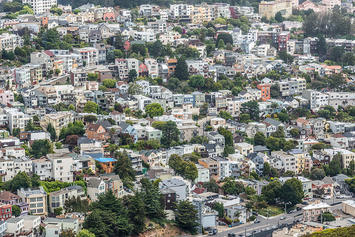
• Annualized new home starts in 3Q17 are up 2.5% compared to 3Q16, while closings are up 1.7%. Quarterly new home starts were up 31% while closings are down 4% compared to 3Q16.
• The average base price for new Single Family detached homes is up 17% YoY to a Metrostudy record, $1.03M; the average price for Attached homes is $905K, an increase of 5%.
• The supply of homes priced under $500k is falling, as prices are increasing in the suburban locations. 28% of new home starts are priced above $1 million. At this point the Sacramento market is more attractive where 70% of the starts are under $500K vs. 12% in the Bay Area.
• The East Contra Costa, Solano, Sacramento and Stockton regions will likely benefit from the expanding Bay Area economy, as homebuyers seek more affordable homes outside of the core Bay area.
Metrostudy’s 3Q17 survey of the San Francisco Bay Area housing market shows that annualized new home starts in 3Q17 are up 2.5% compared to 3Q16, while closings are up 1.7%. Quarterly new home starts were up 31% while closings are down 4% compared to 3Q16. Annual starts have been outpacing closings since 1Q13. As a result, total inventory levels that were once below equilibrium remain at the highest level since 2009. By the end of 2013, the annual start pace had significantly outpaced the annual closing pace mostly due to Condominium starts. Over the past year, total new home inventory has increased 8%.
“The story in this market continues to be affordability, or the lack thereof,” said Greg Gross, Regional Director of Metrostudy’s Northern California market. “Our average “offer to build” base price for new Single Family detached homes is up 17% over a year ago to a Metrostudy record, $1.03M as builders have realized higher land and construction costs, plus strong demand. The average price for Attached homes is $905K, an increase of 5%. Start activity has increased in the price ranges above $800K as builders adjust pricing based on increased demand and higher lot costs. The supply of homes priced under $500k is falling, as prices are increasing in the suburban locations. 28% of new home starts are priced above $1 million. At this point the Sacramento market is more attractive where 70% of the starts are under $500K vs. 12% in the Bay Area.”

While demand remains strong, lot deliveries continue to shrink. Only 3,451 new lots were delivered over the past year, 33% fewer than at this time last year. Months of supply decreased now under 14 months. After a rainy first quarter, new lot development increased significantly this summer. Considering the barriers to development, the market continues to face a lot shortage. More importantly, a more affordable lot shortage.
The Bay Area economy has experienced an exceptional run. Job growth is slowing significantly. Housing demand is strong and the general economic condition in the region is strong. Demand is stabilizing, prices have increased rapidly, and affordability limits are being pushed in almost all sub-markets.
Metrostudy expects demand to remain steady through 2017. But can this demand afford a new home? The overall cost of home ownership is outpacing household income growth in most areas. With prices at or above peak pricing in most sub-markets, buyers may begin to rethink their home-buying decisions and decide to rent or move out of the area. Buyers will calculate the cost of commuting and will factor in those costs when they decide where, or if to purchase a new home.
Given the above, Metrostudy does not expect the housing market to necessarily weaken, but experience more of a stable, slightly lower period of supply and demand into 2018 as the economy continues to moderate and the market adjusts to the rapid increase in home prices. The East Contra Costa, Solano, Sacramento and Stockton regions will likely benefit from the expanding Bay Area economy, as homebuyers seek more affordable homes outside of the core Bay area.
The San Francisco Bay Area market has enjoyed robust economic conditions for nearly seven years, and 2017 will continue this trend. Job growth however slowed significantly from the highs experienced during the second half of 2015. The unemployment rate is also very low and now stands at 4.0 compared to the State level of 5.4%. Most markets are considered to be at Full Employment when the unemployment rate is at 5%. When the rate is below 4%, there is added pressure for companies to find qualified labor. The very low unemployment rate and exorbitant cost of living is undoubtedly having an impact on growth.
This piece originally appeared on Metrostudy.com.
Greg Gross is a Metrostudy Regional Director who played a pivotal role in the launch of Metrostudy’s offices in the Northern California market in 2005, and is responsible for all operations there including research, consulting and managing local client relationships.
Photo: Maciek Lulko, via Flickr, using CC License.












